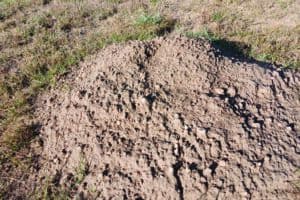Longtime local journalist Bill Radford and his wife, Margaret, live on 5 acres in the Falcon area with ducks, chickens, rabbits, dogs, cats, two noisy parrots, goats and two horses. Contact Bill at billradford3@gmail.com
It has been the summer of the vet visit for us.First up was Nana the goat. She was injured in “the great goat escape,” in which our three goats tore through a section of their pen to go visit the neighbor’s pasture. (That old “the grass is always greener on the other side” thing.) Nana paid a price for those shenanigans, though: She suffered a gaping wound in her side, presumably having gotten snagged on the edge of loose fencing.After a bit of goat-wrangling, we got Nana to the car; to our relief, she hopped into the back seat with no hesitation. We took her to Airway Veterinary Clinic, where we had years before taken another ailing goat, Christmas, who eventually had to be euthanized because of a massive infection that medicines couldn’t conquer. The staff cleaned up Nana’s wound, and Dr. Katie Phillips stitched it up. (During the visit, we also got Nana’s weight for the first time, a figure that, at 155 pounds, took us by surprise. She’s a hefty goat.)We took Nana home but put her in quarantine; we didn’t want the other goats messing with her stitches. Nana’s healing progressed nicely for about two weeks; all we had to do was keep the site clean. But then Nana ended up somehow tearing her stitches open ñ- and we ended up back at the vet’s office.This time, Dr. Gary McEntyre treated Nana. The wound was to the point where he didn’t want to try to stitch it up again. The best approach was to continue to keep it clean and let it heal on its own, he said. His biggest worry was the possibility of flies getting into the wound. He recommended tying a big T-shirt around Nana to cover the wound ñ- something that would protect her but let the wound breathe. Anything we tried kept coming off. We did use SWAT fly ointment and a Vetericyn Plus spray, which helps wounds heal and proved to be a wonder in restoring an injured chicken to health a few years ago. Nana is now fully healed.Not so with Lois the rabbit. Lois lived in an outside pen with bunny buddy Penny, but I noticed she had been hanging out more in their house ñ- an igloo-style doghouse ñ- rather than bounding around in their pen. When I pulled her from the house, she was in bad shape, wobbling back and forth and showing little inclination to get up and move.So off to the vet ñ- not Airway this time because they were busy, but another one we have used. The vet wasn’t hopeful. Lois was in shock, her pupils not reacting to the light he shone in her eyes, and her breathing was labored. Maybe it was her age, maybe it was pneumonia; respiratory problems are common in rabbits.We talked about treatment options ñ- perhaps employing antibiotics and simply working to keep her comfortable ñ- but it was not to be. Lois struggled against getting her temperature taken, and simply trying to control her by gently wrapping her up in a blanket was too much for her. She convulsed, gasped one final time and was gone. But she had lived a good life ñ- eight or nine years, we calculated. (Pet rabbits typically live a lot longer than wild ones, who deal more with disease, starvation and, of course, predators.)As we debated whether to get a companion bunny for Penny, we faced another medical crisis. This one was less severe: Honey the duck was limping. We took her to yet another vet, and she was diagnosed with bumblefoot ñ- which sounds cute but can be deadly if untreated.”If you raise enough chickens or ducks long enough you will most likely be faced with a case or two of bumblefoot,” a post on fresheggsdaily.com reads. “Bumblefoot is basically a staph infection in which bacteria enters a chicken’s (or duck’s) foot through a cut caused by a splinter or other sharp object and causes infection which can travel up the leg.”Honey has been a house duck for more than two weeks now, requiring daily antibiotic and pain medicine; we also wrap her injured foot once or twice a day with fresh bandages. (For a time, we bandaged both feet, since the other foot was also showing signs of bumblefoot.) The vet also suggested soaking Honey’s foot in Epsom salts, but Honey was too interested in drinking the salty water; she has been getting regular baths, though. Her foot is definitely better, and she’s obviously feeling better because she’s putting up much more of a fight when we work to doctor her foot. But we’re wary about putting her back with the other ducks; they don’t exactly keep their quarters in sanitary condition, so we want to make sure Honey is fully recovered before joining the group.So Honey continues to be a house duck, though she spends some time during the day in a pen on the front lawn. The other ducks visited the other day while she was in the pen and they all seemed to have plenty to quack about.






